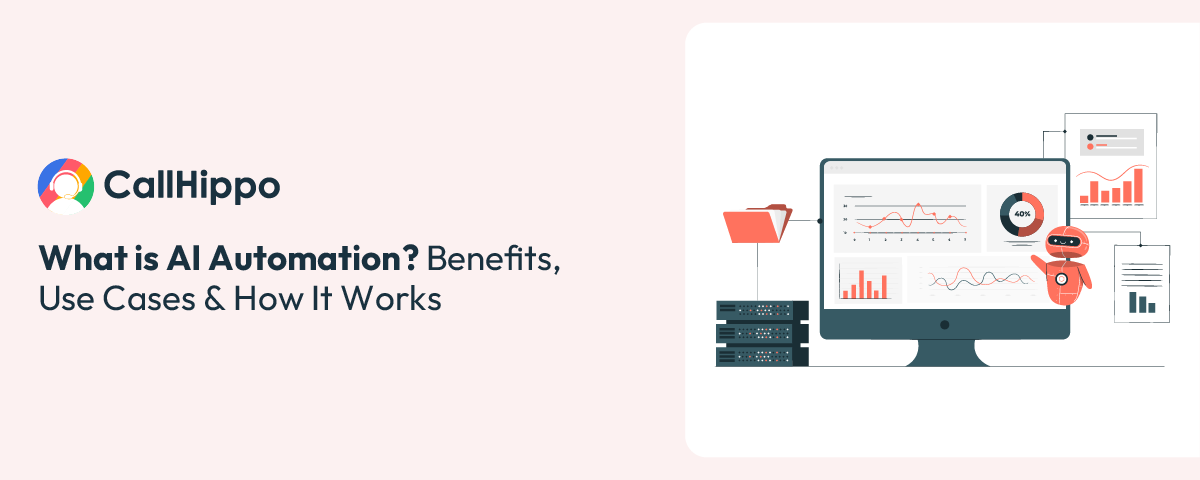10 Seconds to Smarter Business: Understanding AI Automation and Benefits !
AI automation adapts and learns from data, making it capable of handling complex tasks such as decision-making, fraud detection, and predictive maintenance. By integrating AI-powered automation tools, companies can streamline complex tasks, predict the results and manage operations with high accuracy.
- AI automation leverages technologies like machine learning (ML), deep learning (DL), and natural language processing (NLP). These enable AI systems to analyze data, identify patterns, and make predictions, continuously improving their accuracy over time. Cloud services provide the necessary computing power, while constant data collection and preparation ensure ongoing learning.
- Cost Reduction & Efficiency: Automates routine tasks, freeing human employees for strategic work, leading to substantial cost savings and productivity gains.
- 24/7 Operations & Faster Decisions: AI systems operate continuously, providing real-time data analysis and rapid, informed decision-making.
- Enhanced Customer Experiences: AI-powered agents and chatbots deliver instant, personalized support, significantly boosting customer satisfaction.
- Real-time Anomaly Detection: Monitors processes to quickly identify and address unusual patterns or errors, preventing costly mistakes.
- Scalability: Easily adapts and expands to meet growing business demands without requiring extensive additional resources.
Here are some top-rated solutions making waves in the industry:
- Healthcare: Automates scheduling, patient data management, and assists with medical image analysis.
- Manufacturing: Optimizes production lines, predicts maintenance needs, and automates repetitive assembly tasks.
- Finance (Banking, Insurance): AI agents handle customer inquiries, transactions, and detect fraud.
- Retail & E-commerce: Personalizes product suggestions and enhances customer service interactions.
- HR: Automates resume screening, interview scheduling, and employee data management.
- Automotive & Logistics: Assists with vehicle assembly, optimizes routes, and monitors driver behaviour.
AI automation is changing how business improves efficiency, increasing decision-making, and reducing manual labor. By integrating AI-powered automation tools, companies can streamline complex tasks, predict the results and manage operations with high accuracy. The research stated that 75% of organizations have increased their investment in data-life-cycle management due to generative AI. This blog will find out what AI automation is, its benefits, major use cases, and how it works.
Don't try to automate everything at once. Begin with one repetitive process (like customer inquiry routing) and gradually expand. This approach reduces implementation risks and allows your team to adapt comfortably.
How AI Automation is Different from Traditional Automation?
AI automation refers to the use of artificial intelligence to streamline and enhance business processes. It performs tasks that usually require human intelligence, such as decisions, learning from data, and predicting results. In contrast, traditional automation operates on predetermined rules to handle repetitive functions. Here is the breakdown of major differences:
| Feature | AI Automation | Traditional Automation |
|---|---|---|
| Learning Capability | Improves over time using machine learning and predictive analytics. | Does not learn; operates on predefined rules. |
| Task Complexity | Handles complex tasks like fraud detection and predictive maintenance. | Limited to simple, repetitive tasks. |
| Decision Making | Makes data-driven decisions by analyzing real-time patterns. | Based on static rules, no real-time decision-making. |
| Integration | Seamlessly integrates with existing systems. | Often requires manual integration. |
| Adaptability | Adapts to changing conditions over time. | No adaptability; fixed processes. |
| Scope | Handles dynamic, wide-ranging tasks. | Focuses on routine, repetitive actions. |
| Efficiency & Cost | Improves efficiency and reduces errors, saving time and money. | Less efficient, with more errors and delays. |
AI automation stands out not only by reducing manual labor but also by enabling overall efficiency, adapting to changing situations, and making more intelligent decisions.
How Does AI Automation Work?
The AI automation uses techniques such as automation, machine learning, deep learning, and natural language processing (NLP), which automate the tasks done by humans. These technologies help machines analyse unstructured data management, https://callhippo.com/blog/ai/ai-automationmake decisions, and improve efficiency.
1. AI and Automation Technologies Behind the Process
AI uses algorithms and models to process data, automation, identify patterns, and make predictions. AI automation tools are integrated into existing business systems to automate tasks such as data entry, customer support, and decision-making. These models learn from new data, making them more accurate over time. This ability to adapt is a significant advantage of AI automation over traditional methods.
2. Machine Learning, Deep Learning & NLP in Automation
- Machine Learning (ML): ML allows AI systems to learn from data and improve decision-making. It is used for tasks such as fraud detection and customer feedback analysis.
- Deep Learning (DL): DL helps AI make complex decisions by simulating the human brain. It is useful in tasks like image recognition and speech processing.
- Natural Language Processing (NLP): NLP enables AI to understand and respond to human language. It is used in chatbots and voice assistants, making interactions more natural.
3. Cloud Services and Foundational Models Powering Automation AI
Cloud services provide the computing power required for the AI model. They allow businesses to scale AI solutions without investing in expensive hardware. Pre-trained AI models and neural networks are available on the cloud, allowing businesses to integrate AI tools quickly. The cloud also ensures that the AI system is up-to-date with regular updates.
4. The Role of Data: Collection, Preparation, and Continuous Learning
Data is the foundation of AI automation. The process begins with data collection, where relevant information is gathered. Next, the data goes through data preparation, involving cleaning and organizing. Finally, continuous learning allows AI to adapt and improve as more data is processed. This ongoing learning helps the AI stay effective and accurate over time.
Key Benefits of Artificial Intelligence Automation
AI is bringing a revolution in the automation of business operations. It reduces costs, increases efficiency, and improves customer experiences. Here are the main benefits:
1. Reduced Operational Costs and Improved Efficiency
AI automation reduces manual functions while saving valuable time. This automates processes such as data entry and scheduling, allowing employees to focus on more important tasks. Over time, AI systems handle large volumes with low errors. This causes cost savings and improves overall productivity.
2. 24/7 Automation with Faster Decision-Making
AI automation works continuously without downtime. It operates 24/7, making fast decisions by analyzing data in real time. This improves the speed of business reactions. The AI system can handle immediate tasks at any time, can increase the availability of service, and reduce the delay in decision-making.
3. Enhanced Customer Experiences through AI Agents
AI agents such as chatbots provide immediate, accurate support. They can answer the customer’s questions, providing persistent reactions. Using natural language processing (NLP), the AI understands and addresses the needs of the customer. This helps businesses create more personalized and positive customer experiences.
4. Real-Time Anomaly Detection and Error Prevention
AI monitors business processes in real time, detecting issues as they arise. It flags off unusual patterns and errors quickly, allowing businesses to take immediate action. AI learns from previous mistakes and improves its detection over time. This active approach reduces expensive errors and ensures smooth operation.
5. Scalability for Growing Business Needs.
AI systems can easily scale for business growth. As soon as a company expands, AI tools can handle data and tasks efficiently. Businesses do not need to worry about advancing their automation systems. AI is favorable for increasing demand, helping companies to scale without needing additional resources.
Use Cases of AI Automation Across Industries
Did you know that agentic AI will autonomously resolve 80% of common customer service issues without human intervention by 2029, leading to a 30% reduction in operational costs. AI is changing various industries by improving automation efficiency and cutting costs. Here is how it is being used in various fields:
1. AI Automation in Healthcare
AI helps automate tasks like scheduling and managing patient data. It provides 24/7 call answering, so patients can get help anytime. AI tools also assist doctors by analyzing medical images. Multilingual conversations make healthcare accessible to more people.
2. AI Automation in Manufacturing
AI helps optimize production planning and predict when maintenance of production line is needed. It takes over repetitive tasks like assembly and quality checks. Task automation reduces errors and boosts productivity. AI also helps teams communicate smoothly across platforms.
3. AI Automation in Banking, Insurance, and Financial Services
AI agents answer customer questions and handle transactions. They can spot fraud by analyzing transaction data. Emotion recognition helps understand how customers feel. 24/7 Call AI answering service ensures customers can get help whenever they need it.
4. AI Automation in Retail, eCommerce, and Customer Service
AI suggests products based on customer preferences. It also improves customer service by offering personalized interactions. If needed, AI can transfer calls to humans for further assistance. It helps manage inquiries and provides quicker responses.
5. HR Onboarding and Internal Workflows
AI automates tasks like resume screening and interview scheduling. It helps manage employee data and tracks performance. Task automation makes HR processes quicker and easier. AI also gives helpful insights to improve HR decisions.
6. Automotive and Logistics
AI assists with vehicle assembly and quality control in automotive manufacturing. In logistics, it helps optimize routes and manage deliveries. AI tools also monitor driver behavior for safety. Omnichannel support helps keep everyone on the same page.
How AI Agents Are Changing the Future of Automation
AI agents are changing automation by making tasks smarter and more efficient. They can handle complex processes, improve decision-making, and provide personal interactions within industries.
1. What are AI Agents, and How Do They Operate?
AI agents are intelligent systems that use machine learning and data to perform tasks that usually require human effort. They learn from each interaction, allowing them to adapt and improve over time.
- Use machine learning algorithms to make data-powered decisions.
- Work through natural language processing (NLP) to understand the voice or text.
- Constant improvement by learning from past interactions.
- Can automate repetitive tasks and complex processes.
2. CallHippo AI Voice Agent
CallHippo AI Voice Agent provides businesses with seamless, 24/7 customer service through automated calls. These AI-powered systems can handle a variety of tasks, including answering queries and transferring calls to humans when needed.
- 24/7 customer support: Our AI Voice Agent provides round-the-clock service.
- Human-like conversations: They offer natural, human-like interactions with customers.
- Call transfers: For complex issues, calls can be transferred to human agents seamlessly.
- Natural language processing: They understand and respond to customer inquiries effectively.
- Multilingual support: The agents can handle conversations in multiple languages, making them accessible globally
Per User/Month
- Automated Meeting Scheduling
- Transfer Call to Human Agent
- Multilingual Support
- Calendar Booking Assistant

Challenges and Considerations in AI Automation
AI automation provides great benefits, but it also presents challenges. Businesses must address these issues to implement the AI systems successfully.
1. AI Bias, Transparency, and Decision Ethics
AI systems rely on data to decide. If the data is biased, the results may be inappropriate. Transparency is important, so everyone understands how AI decides. Businesses must ensure AI algorithms make ethical choices, especially in sensitive areas like hiring or law enforcement. For example, Amazon’s AI hiring tool was found to be biased against female candidates. The system was trained on the resume presented by most male applicants. As a result, AI was in favor of male candidates, which highlighted the importance of fairness and transparency.
2. Data Privacy and Security Risks
AI systems handle large amounts of sensitive data. If not preserved, this data can be accessed by unauthorized parties. Businesses should follow data privacy laws such as GDPR. Any data breach can damage the reputation of a company and result in legal penalties. For example, Facebook faced heavy fines for incorrectly managing user data in 2018. This violation affected millions of people and damaged the company’s trust. This reflects the important requirement of safe data handling in the AI system.
3. Implementation Hurdles: Cost, Expertise, and Scalability
AI automation can be expensive to implement. Companies need to invest in technology and skilled professionals. Additionally, AI systems must be scalable to grow with the business. Without careful planning, these challenges can delay AI adoption. General Electric faced high costs when implementing AI in maintenance systems. The company had to invest in both technology and training. This example shows how resource-intensive AI adoption can be, especially in large-scale operations.
4. Overcoming Resistance to Change in Traditional Teams
Employees may oppose AI adoption due to fear of job loss or being unfamiliar with technology. Clear communication and proper training can reduce this resistance. Early involvement of employees in this process helps them to adapt to change. IBM faced initial resistance to the AI tool for customer service. However, with training and communication, employees adopted new technology. This suggests how attractive teams can help overcome quick resistance.
The Future of AI and Automation
AI and automation are transforming industries worldwide by providing businesses with rapid solutions, enhanced customer service, and improved decision-making capabilities. Adopting AI is no longer optional but essential for remaining competitive in today’s market.
1. AI for Automation: Why Now is the Time to Adopt
The growing demand for quick, effective customer service makes AI automation crucial for modern businesses. AI enables companies to automate routine tasks like answering common queries and processing requests 24/7, with projections showing AI will add $15.7 trillion to the global economy by 2030. AI-powered voice agents can handle customer inquiries around the clock, eliminating delays and improving satisfaction through fast, personalized responses.
2. Intelligent Automation and Human-AI Collaboration
While AI excels at handling repetitive tasks, human cooperation remains essential for complex scenarios requiring emotional intelligence or deep knowledge. AI agents manage routine customer inquiries while human agents focus on challenging issues, creating a balanced system. AI systems can seamlessly transfer complex calls to human agents and continuously learn from past interactions to improve future responses.
3. Evolving Job Roles and Upskilling for the AI Era
As AI integrates into business processes, job roles are evolving rather than disappearing, with employees freed from repetitive tasks to focus on strategic activities. Workers need to acquire new skills to manage AI-powered tools, interpret data, and oversee automation systems. This upskilling ensures employees remain relevant in the AI-driven world while contributing to business growth.
"Invest in no-code AI platforms. These platforms allow businesses to deploy AI solutions quickly without the need for extensive technical knowledge, making AI automation more accessible."
4. No-Code AI Platforms and Democratization of Automation
No-code AI platforms make automation accessible to businesses of all sizes by allowing companies to create AI-operated systems without specialized coding skills. These platforms enable businesses to integrate AI-powered voice agents and automate customer service without complex setup or extensive technical expertise. By making AI tools user-friendly, companies can enhance operations without heavy investments in development resources.
5. AI Automation as a Pillar of Digital Transformation
AI automation serves as a cornerstone of digital transformation, enabling businesses to automate key processes, improve efficiency, and enhance customer service. Integrating AI-driven tools helps companies modernize operations, streamline workflows, and better meet customer expectations. AI systems that provide 24/7 support and understand customer queries are becoming essential for competitive advantage in the digital era.
Closing Thoughts
AI automation is transforming how businesses operate by improving efficiency, reducing costs, and enhancing customer experiences. By integrating AI-powered tools, companies can streamline tasks, make data-driven decisions, and stay competitive. As AI continues to evolve, it will play an even bigger role in reshaping industries, driving smarter operations, and enhancing business growth. The future of AI automation is bright, and businesses that embrace it will be better equipped to thrive in an increasingly digital world.
FAQs
1. What is AI automation, and how is it used in business?
AI automation uses artificial intelligence to handle tasks that usually need human intelligence, like decision-making and data analysis. Businesses use AI-powered tools to automate routine tasks, improve efficiency, and enhance customer experiences. For example, AI systems can answer customer inquiries 24/7 and analyze data in real time.
2. What is the most advanced automation?
The most advanced automation is intelligent automation, which combines machine learning, natural language processing (NLP), and robotic process automation (RPA). This automation adapts and learns from data, handling complex tasks that traditional automation cannot.
3. Is AI automation difficult or expensive to implement?
AI automation can be expensive initially, but it pays off over time by increasing efficiency and reducing labor costs. The use of no-code AI platforms has made implementation easier and more affordable for businesses. AI tools help streamline operations and improve productivity in the long run.
4. Does AI automation replace human workers?
AI automation does not replace workers but helps them by taking over repetitive tasks. It handles jobs like data entry and customer queries, allowing employees to focus on more strategic work. Human-AI collaboration boosts productivity and supports smarter decision-making.

Subscribe to our newsletter & never miss our latest news and promotions.









